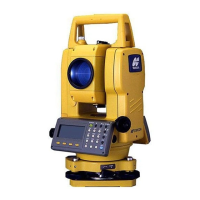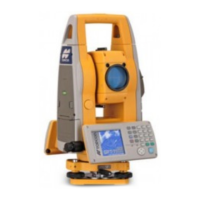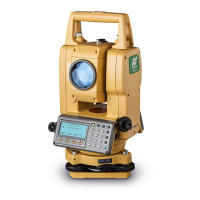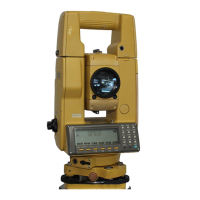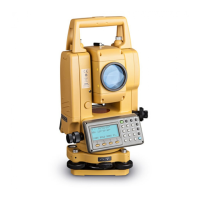Do you have a question about the Topcon GTS-605 and is the answer not in the manual?
Precautions for safe operation and handling of the instrument.
Detailed safety warnings and precautions related to instrument use and hazards.
Information on laser safety standards and classification for the instrument.
Identifies and labels the different parts of the instrument.
Explains the instrument's display, including data and soft key functions.
Step-by-step guide for setting up the instrument on a tripod and leveling.
How to compensate for instrument errors like collimation and axis errors.
Procedures for measuring horizontal and vertical angles.
Procedures for setting corrections and performing distance measurements.
Steps for setting occupied point coordinates and executing measurements.
Computing backsight orientation angle using occupied and backsight points.
Assisting users in staking out points using coordinate values.
Setting communication parameters like Baud rate.
Detailed configuration for measurement, communication, and password settings.
Procedure for checking and adjusting the instrument's constant value.
How to check if the EDM and theodolite optical axes match.
Procedures for checking and adjusting theodolite functions.
Software compensation for systematic errors like tilt and collimation.
Setting the instrument constant value obtained from calibration.
Methods for setting atmospheric correction values directly or via chart.
Instructions for removing, charging, refreshing, and installing the battery.
Information about the instrument's on-board battery.
Information about external battery packs and their charging.
Explanation and formulas for dual axis compensation of angle errors.
Guidelines for charging and storing batteries to maximize lifespan.
Precautions for safe operation and handling of the instrument.
Detailed safety warnings and precautions related to instrument use and hazards.
Information on laser safety standards and classification for the instrument.
Identifies and labels the different parts of the instrument.
Explains the instrument's display, including data and soft key functions.
Step-by-step guide for setting up the instrument on a tripod and leveling.
How to compensate for instrument errors like collimation and axis errors.
Procedures for measuring horizontal and vertical angles.
Procedures for setting corrections and performing distance measurements.
Steps for setting occupied point coordinates and executing measurements.
Computing backsight orientation angle using occupied and backsight points.
Assisting users in staking out points using coordinate values.
Setting communication parameters like Baud rate.
Detailed configuration for measurement, communication, and password settings.
Procedure for checking and adjusting the instrument's constant value.
How to check if the EDM and theodolite optical axes match.
Procedures for checking and adjusting theodolite functions.
Software compensation for systematic errors like tilt and collimation.
Setting the instrument constant value obtained from calibration.
Methods for setting atmospheric correction values directly or via chart.
Instructions for removing, charging, refreshing, and installing the battery.
Information about the instrument's on-board battery.
Information about external battery packs and their charging.
Explanation and formulas for dual axis compensation of angle errors.
Guidelines for charging and storing batteries to maximize lifespan.
| Type | Total Station |
|---|---|
| Angle Measurement Accuracy | 5" |
| Display | LCD |
| Battery Life | 10 hours |
| Telescope Magnification | 30x |
| Operating Temperature Range | -20°C to +50°C |
| Maximum Range (with prism) | 5000m |
| Minimum Reading | 0.1mm |
| Compensator | Dual Axis |





